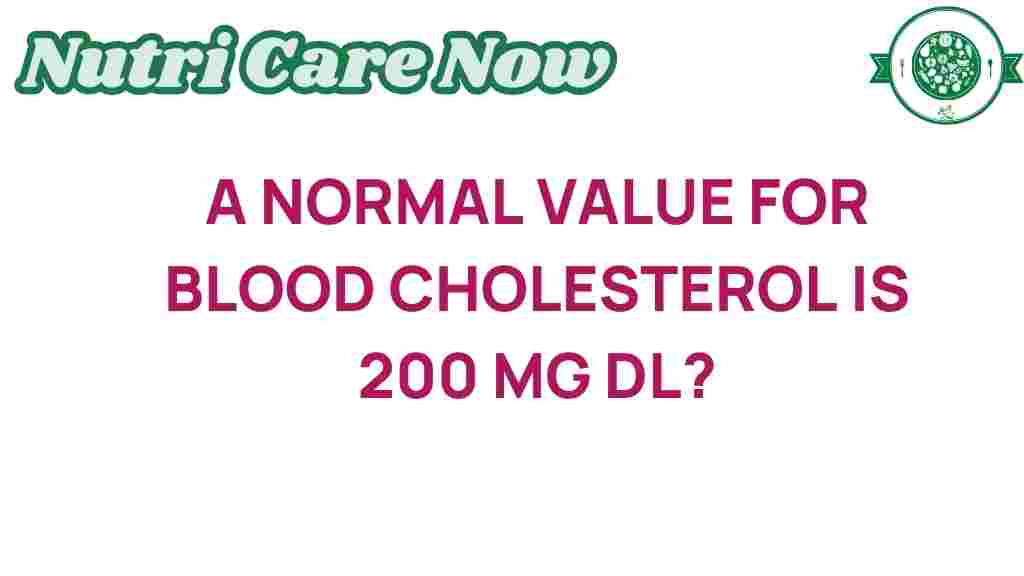Unraveling the Myths: Is a Normal Cholesterol Level Really 200 mg/dL?
Cholesterol is a substance that often finds itself at the center of health discussions, particularly when it comes to heart health. Many people believe that a normal cholesterol level is strictly 200 mg/dL, but is that really the case? In this article, we will explore the myths surrounding cholesterol levels, delve into the factors that influence these values, and provide insights into maintaining optimal health through lifestyle and nutrition. We aim to clarify what constitutes a normal cholesterol level and why understanding this is crucial for heart health.
Understanding Cholesterol and Its Importance
Cholesterol is a waxy substance found in your blood and is vital for the formation of cell membranes, certain hormones, and vitamin D. It is transported through the bloodstream by lipoproteins, which are classified into two main types: low-density lipoprotein (LDL) and high-density lipoprotein (HDL).
- LDL Cholesterol: Often referred to as “bad” cholesterol, high levels of LDL can lead to plaque buildup in arteries, increasing the risk of heart disease.
- HDL Cholesterol: Known as “good” cholesterol, HDL helps remove LDL cholesterol from the bloodstream, thus protecting against heart disease.
When discussing cholesterol levels, it’s crucial to consider both LDL and HDL levels, as they play significant roles in overall health.
Normal Values: What Do They Really Mean?
The general guidelines for cholesterol levels according to health organizations are as follows:
- Total Cholesterol: Less than 200 mg/dL is considered desirable.
- LDL Cholesterol: Less than 100 mg/dL is optimal.
- HDL Cholesterol: 60 mg/dL or higher is considered protective against heart disease.
However, it’s important to note that “normal” values can vary based on individual health conditions, family history, and lifestyle factors. Therefore, while 200 mg/dL is often cited as a threshold, it is not the sole indicator of heart health.
Myth-Busting: Common Misconceptions About Cholesterol
Let’s debunk some prevalent myths surrounding cholesterol levels:
- Myth 1: All cholesterol is bad.
In reality, cholesterol is essential for various bodily functions. The focus should be on managing the balance between LDL and HDL. - Myth 2: A cholesterol level of 200 mg/dL is a definitive indicator of health.
Cholesterol levels should be interpreted alongside other risk factors, including blood pressure, smoking status, and family history. - Myth 3: You can’t control your cholesterol levels.
Lifestyle choices can significantly impact cholesterol levels. Nutrition and exercise play critical roles in managing cholesterol.
Factors Affecting Cholesterol Levels
Several factors can influence cholesterol levels, including:
- Diet: Foods high in saturated fats and trans fats can raise LDL levels, while healthy fats from sources like fish and nuts can improve HDL levels.
- Physical Activity: Regular exercise can help raise HDL cholesterol.
- Weight: Being overweight can contribute to higher LDL levels.
- Age and Gender: Cholesterol levels can change with age, and women often experience changes post-menopause.
- Genetics: Family history can play a significant role in how your body processes cholesterol.
Step-by-Step: How to Manage Your Cholesterol Levels
Managing cholesterol levels is a proactive process. Here’s a step-by-step guide:
Step 1: Get Regular Blood Tests
Schedule regular blood tests to monitor your cholesterol levels. It’s essential to understand your total cholesterol, LDL, and HDL levels. Consult with your healthcare provider for personalized advice based on your results.
Step 2: Evaluate Your Diet
Focus on a heart-healthy diet that includes:
- Fruits and Vegetables: Rich in fiber and antioxidants.
- Whole Grains: Oats, brown rice, and whole grain bread can help lower LDL levels.
- Healthy Fats: Incorporate sources of omega-3 fatty acids, such as salmon, walnuts, and flaxseeds.
- Limit Processed Foods: Reduce intake of foods high in saturated and trans fats.
Step 3: Increase Physical Activity
Engage in regular physical activity to improve HDL levels and help maintain a healthy weight. Aim for at least 150 minutes of moderate aerobic exercise each week.
Step 4: Maintain a Healthy Weight
Achieving and maintaining a healthy weight can positively impact your cholesterol levels. Even a modest weight loss can help lower LDL cholesterol.
Step 5: Avoid Tobacco Smoke and Limit Alcohol
Avoiding tobacco smoke and limiting alcohol consumption can improve your overall heart health. Smoking cessation is particularly effective in improving HDL cholesterol levels.
Nutrition Tips for Healthy Cholesterol Levels
Nutrition plays a pivotal role in managing cholesterol. Here are some additional tips:
- Include Soluble Fiber: Foods like oats, beans, lentils, and fruits can help lower cholesterol.
- Incorporate Healthy Oils: Use olive oil or avocado oil instead of butter or margarine.
- Choose Lean Proteins: Opt for skinless poultry, fish, and plant-based proteins.
- Limit Sugary Foods: High sugar intake can lead to higher cholesterol levels.
Troubleshooting: What to Do If Your Cholesterol Levels Are High
If you find that your cholesterol levels are higher than the recommended values, consider the following:
- Consult with a Healthcare Provider: Get personalized medical advice tailored to your needs.
- Consider Medication: If lifestyle changes aren’t enough, your doctor may recommend cholesterol-lowering medications.
- Monitor Regularly: Keep track of your cholesterol levels to see how changes in lifestyle or medication are affecting them.
Conclusion: Taking Charge of Your Cholesterol and Heart Health
In conclusion, while a total cholesterol level of 200 mg/dL is often referred to as normal, the reality is more nuanced. Understanding cholesterol levels requires a comprehensive view that takes into account other health factors and lifestyle choices. By debunking myths and focusing on healthy nutrition and lifestyle, individuals can take charge of their heart health.
Regular blood tests, a balanced diet, and an active lifestyle are key components of managing cholesterol levels effectively. Remember, always seek medical advice tailored to your unique health situation. For more information on heart health, consider visiting Heart Health Resources.
Taking proactive steps today can lead to a healthier tomorrow, ensuring that you maintain your heart health and overall well-being.
This article is in the category Health and created by NutriCareNow Team
